- ▶
- Heaters/Source
- ▶
- Agilent Heaters and SensorsMass Spectrometry, Scientific Supplies & ManufacturingScientific Instrument Services 5973 Source Heater Tamper Resistant Allen Wrench 5973/5975 Quad Sensor 5985 Source Heater Assembly Agilent Interface Heater Assembly 5971 Interface Heater

- ▶
- Reference Material on InstrumentationArticle - A High Temperature Direct Probe for a Mass Spectrometer Design of a Direct Exposure Probe and Controller for use ona Hewlett-Packard 5989 Mass Spectrometer SIS AP1000 AutoProbe™ SIS AP2000 AutoProbe™ - Description of System HPP7: Direct Probe Electronics Console HPP7: Direct Probe for the Agilent (HP) 5973/5975 MSD HPP7: HP Direct Probe Application Notes HPP7: Installation Directions for the Direct Probe HPP7: Side Cover for the HP 5973 MSD HPP7: Support HPP7: Probe Inlet System for the Agilent (HP) 5973 and 5975 MSD with Automatic Indexed Stops HPP7: Theory of Operation of the Direct Probe and Probe Inlet System Direct Thermal Extraction Thermal Desorption Application Notes Environmental Thermal Desorption Application Notes Food Science Thermal Desorption Application Notes Forensic Thermal Desorption Application Notes GC Cryo-Trap Application Notes Headspace Application Notes Purge & Trap Thermal Desorption Application Notes Theory of Operation of the AutoDesorb® System AutoDesorb Notes for SIS Dealers Adsorbent Resin Application Notes Installation of the Short Path Thermal Desorption System on Agilent (HP) and Other GCs Installation of the Short Path Thermal Desorption System on a Varian 3400 GC AutoDesorb® System Development Team Thermal Desorption Applications and Reference Materials Installation of the Short Path Thermal Desorption System - TD5 Part I - Design & Operation of the Short Path ThermalDesorption System Installation Instructions for the Model 951 GC Cryo-Trap on the HP 5890 Series GC Installation Instructions for the Model 961 GC Cryo-Trap on the HP 5890 Series GC Operation of the Model 951/961 GC Cryo-Trap SIS GC Cryo Traps - Theory of Operation NIST/EPA/NIH Mass Spectral Enhancements - 1998 version (NIST98) SIMION 3D Ion Optics Class Mass Spectrometer Source Cleaning Methods MS Tip: Mass Spectrometer Source Cleaning Procedures Mass Spec Source Cleaning Procedures Micro-Mesh® Abrasive Sheets Research Papers Using New Era Syringe Pump Systems EI Positive Ion Spectra for Perfluorokerosene (PFK) Cap Liner Information How do I convert between fluid oz and milliliters? Which bottle material should I choose? Which bottle mouth should I choose? The Bottle Selection Guide CGA Connections for Gas Tanks Chemical Reaction Interface Mass Spectrometry (CRIMS)

- TD
- ▶
- AccessoriesTD Supply Kit Desorption Tubes Adsorbent Resins Desorption Tube Needles Desorption Tube Seals Desorption System Fittings GC Cryo-Trap Extraction Cell TD Sample Loader Prepacked, Conditioned Desorption Tubes Desorption Tube Packing Accessories Stainless Steel Purge Heads Injection Port Liners Tenax TA Poster TD Application Notes Customer Service

- LiteratureApplication Notes Adsorbent Resins Guide Mass Spec Tips SDS Sheets FAQ MS Calibration Compound Spectra Manuals MS Links/Labs/ Organizations MS Online Tools Flyers on Products/Services Scientific Supplies Catalog About Us NextAdvance Bullet Blender® Homogenizer Protocols Micro-Mesh® Literature Instrumentation Literature Agilent GC/MS Literature SIS News / E-Mail Newsletter NIST MS Database - Update Notifications

- ▶
- Thermal Desorption Applications and Reference MaterialsDirect Thermal Extraction Headspace Environmental Food Science Applications Pharmaceuticals Forensic Note 103: EPA Method 325B, Novel Thermal Desorption Instrument Modification to Improve Sensitivity Note 102: Identification of Contaminants in Powdered Beverages by Direct Extraction Thermal Desorption GC/MS Note 101: Identification of Contaminants in Powdered Foods by Direct Extraction Thermal Desorption GC/MS Note 100: Volatile and Semi-Volatile Profile Comparison of Whole Versus Cracked Versus Dry Homogenized Barley Grains by Direct Thermal Extraction Note 99: Volatile and Semi-Volatile Profile Comparison of Whole vs. Dry Homogenized Wheat, Rye and Barley Grains by Direct Thermal Extraction GC/MS Note 98: Flavor and Aroma Profiles of Truffle Oils by Thermal Desorption GC/MS Note 97: Flavor Profiles of Imported and Domestic Beers by Purge & Trap Thermal Desorption GC/MS Note 95: Detection of Explosives on Clothing Material by Direct and AirSampling Thermal Desorption GC/MS Note 94: Detection of Nepetalactone in the Nepeta Cataria Plant by Thermal Desorption GC/MS Note 93: Detection of Benzene in Carbonated Beverages with Purge & Trap Thermal Desorption GC/MS Note 88: Analysis of Silicone Contaminants on Electronic Components by Thermal Desorption GC-MS Note 84: Vacuum Pump Exhaust Filters - Charcoal Exhaust Traps Note 83: Vacuum Pump Exhaust Filters - Oil Mist Eliminators Note 82: Vacuum Pump Exhaust Filters Note 80: Design, Development and Testing of a Microprocessor ControlledAutomated Short Path Thermal Desorption Apparatus Note 79: Volatile Organic Compounds From Electron Beam Cured and Partially Electron Beam Cured Packaging Using Automated Short Path Thermal Desorption Note 77: The Determination of Volatile Organic Compounds in VacuumSystem Components Note 75: An Apparatus for Sampling Volatile Organics From LivePlant Material Using Short Path Thermal Desorption Note 73: The Analysis of Perfumes and their Effect on Indoor Air Pollution Note 71: Flavor Profile Determination of Rice Samples Using Shor tPath Thermal Desorption GC Methods Note 65: Determination of Ethylene by Adsorbent Trapping and Thermal Desorption - Gas Chromatography Note 64: Comparison of Various GC/MS Techniques For the Analysis of Black Pepper (Piper Nigrum) Note 63: Determination of Volatile and Semi-Volatile Organics in Printer Toners Using Thermal Desorption GC Techniques Note 60: Programmable Temperature Ramping of Samples Analyzed ViaDirect Thermal Extraction GC/MS Note 57: Aroma Profiles of Lavandula species Note 55: Seasonal Variation in Flower Volatiles Note 54: Identification of Volatile Organic Compounds in Office Products Note 43: Volatile Organic Composition In Blueberries Note 42: The Influence of Pump Oil Purity on Roughing Pumps Note 41: Hydrocarbon Production in Pine by Direct Thermal Extraction Note 40: Comparison of Septa by Direct Thermal Extraction Note 39: Comparison of Sensitivity Of Headspace GC, Purge and Trap Thermal Desorption and Direct Thermal Extraction Techniques For Volatile Organics Note 38: A New Micro Cryo-Trap For Trapping Of Volatiles At the Front Of a GC Capillary Column Note 37: Volatile Organic Emissions from Automobile Tires Note 36: Identification Of Volatile Organic Compounds In a New Automobile Note 35: Volatile Organics Composition of Cranberries Note 34: Selection Of Thermal Desorption and Cryo-Trap Parameters In the Analysis Of Teas Note 33: Changes in Volatile Organic Composition in Milk Over Time Note 32: Selection and Use of Adsorbent Resins for Purge and Trap Thermal Desorption Applications Note 31: Volatile Organic Composition in Several Cultivars of Peaches Note 30: Comparison Of Cooking Oils By Direct Thermal Extraction and Purge and Trap GC/MS Note 29: Analysis Of Volatile Organics In Oil Base Paints By Automated Headspace Sampling and GC Cryo-Focusing Note 28: Analysis Of Volatile Organics In Latex Paints By Automated Headspace Sampling and GC Cryo-Focusing Note 27: Analysis of Volatile Organics In Soils By Automated Headspace GC Note 26: Volatile Organics Present in Recycled Air Aboard a Commercial Airliner Note 25: Flavor and Aroma in Natural Bee Honey Note 24: Selection of GC Guard Columns For Use With the GC Cryo-Trap Note 23: Frangrance Qualities in Colognes Note 22: Comparison Of Volatile Compounds In Latex Paints Note 21: Detection and Identification Of Volatile and Semi-Volatile Organics In Synthetic Polymers Used In Food and Pharmaceutical Packaging Note 20: Using Direct Thermal Desorption to Assess the Potential Pool of Styrene and 4-Phenylcyclohexene In Latex-Backed Carpets Note 19: A New Programmable Cryo-Cooling/Heating Trap for the Cryo-Focusing of Volatiles and Semi-Volatiles at the Head of GC Capillary Columns Note 18: Determination of Volatile Organic Compounds In Mushrooms Note 17: Identification of Volatile Organics in Wines Over Time Note 16: Analysis of Indoor Air and Sources of Indoor Air Contamination by Thermal Desorption Note 14: Identification of Volatiles and Semi-Volatiles In Carbonated Colas Note 13: Identification and Quantification of Semi-Volatiles In Soil Using Direct Thermal Desorption Note 12: Identification of the Volatile and Semi-Volatile Organics In Chewing Gums By Direct Thermal Desorption Note 11: Flavor/Fragrance Profiles of Instant and Ground Coffees By Short Path Thermal Desorption Note 10: Quantification of Naphthalene In a Contaminated Pharmaceutical Product By Short Path Thermal Desorption Note 9: Methodologies For the Quantification Of Purge and Trap Thermal Desorption and Direct Thermal Desorption Analyses Note 8: Detection of Volatile Organic Compounds In Liquids Utilizing the Short Path Thermal Desorption System Note 7: Chemical Residue Analysis of Pharmaceuticals Using The Short Path Thermal Desorption System Note 6: Direct Thermal Analysis of Plastic Food Wraps Using the Short Path Thermal Desorption System Note 5: Direct Thermal Analysis Using the Short Path Thermal Desorption System Note 4: Direct Analysis of Spices and Coffee Note 3: Indoor Air Pollution Note 2: Detection of Arson Accelerants Using Dynamic Headspace with Tenax® Cartridges Thermal Desorption and Cryofocusing Note 1: Determination of Off-Odors and Other Volatile Organics In Food Packaging Films By Direct Thermal Analysis-GC-MS

- Application NotesNote 103: EPA Method 325B, Novel Thermal Desorption Instrument Modification to Improve Sensitivity Note 102: Identification of Contaminants in Powdered Beverages by Direct Extraction Thermal Desorption GC/MS Note 101: Identification of Contaminants in Powdered Foods by Direct Extraction Thermal Desorption GC/MS Note 100: Volatile and Semi-Volatile Profile Comparison of Whole Versus Cracked Versus Dry Homogenized Barley Grains by Direct Thermal Extraction Note 99: Volatile and Semi-Volatile Profile Comparison of Whole vs. Dry Homogenized Wheat, Rye and Barley Grains by Direct Thermal Extraction GC/MS Note 98: Flavor and Aroma Profiles of Truffle Oils by Thermal Desorption GC/MS Note 97: Flavor Profiles of Imported and Domestic Beers by Purge & Trap Thermal Desorption GC/MS Note 96: Reducing Warping in Mass Spectrometer Filaments, with SISAlloy® Yttria/Rhenium Filaments Note 95: Detection of Explosives on Clothing Material by Direct and AirSampling Thermal Desorption GC/MS Note 94: Detection of Nepetalactone in the Nepeta Cataria Plant by Thermal Desorption GC/MS Note 93: Detection of Benzene in Carbonated Beverages with Purge & Trap Thermal Desorption GC/MS Note 92: Yttria Coated Mass Spectrometer Filaments Note 91: AutoProbe DEP Probe Tip Temperatures Note 90: An Automated MS Direct Probe for use in an Open Access Environment Note 89: Quantitation of Organics via a Mass Spectrometer Automated Direct Probe Note 88: Analysis of Silicone Contaminants on Electronic Components by Thermal Desorption GC-MS Note 87: Design and Development of an Automated Direct Probe for a Mass Spectrometer Note 86: Simulation of a Unique Cylindrical Quadrupole Mass Analyzer Using SIMION 7.0. Note 85: Replacing an Electron Multiplier in the Agilent (HP) 5973 MSD Note 84: Vacuum Pump Exhaust Filters - Charcoal Exhaust Traps Note 83: Vacuum Pump Exhaust Filters - Oil Mist Eliminators Note 82: Vacuum Pump Exhaust Filters Note 81: Rapid Bacterial Chemotaxonomy By DirectProbe/MSD Note 80: Design, Development and Testing of a Microprocessor ControlledAutomated Short Path Thermal Desorption Apparatus Note 79: Volatile Organic Compounds From Electron Beam Cured and Partially Electron Beam Cured Packaging Using Automated Short Path Thermal Desorption Note 78: A New Solution to Eliminate MS Down-Time With No-Tool-Changing of Analytical GC Columns Note 77: The Determination of Volatile Organic Compounds in VacuumSystem Components Note 76: Determination of the Sensitivity of a CRIMS System Note 75: An Apparatus for Sampling Volatile Organics From LivePlant Material Using Short Path Thermal Desorption Note 74: Examination of Source Design in Electrospray-TOF Using SIMION 3D Note 73: The Analysis of Perfumes and their Effect on Indoor Air Pollution Note 72: 1998 Version of the NIST/EPA/NIH Mass Spectral Library, NIST98 Note 71: Flavor Profile Determination of Rice Samples Using Shor tPath Thermal Desorption GC Methods Note 70: Application of SIMION 6.0 To a Study of the Finkelstein Ion Source: Part II Note 69: Application of SIMION 6.0 To a Study of the Finkelstein Ion Source: Part 1 Note 68: Use of a PC Plug-In UV-Vis Spectrometer To Monitor the Plasma Conditions In GC-CRIMS Note 67: Using Chemical Reaction Interface Mass Spectrometry (CRIMS) To Monitor Bacterial Transport In In Situ Bioremediation Note 66: Probe Tip Design For the Optimization of Direct Insertion Probe Performance Note 65: Determination of Ethylene by Adsorbent Trapping and Thermal Desorption - Gas Chromatography Note 64: Comparison of Various GC/MS Techniques For the Analysis of Black Pepper (Piper Nigrum) Note 63: Determination of Volatile and Semi-Volatile Organics in Printer Toners Using Thermal Desorption GC Techniques Note 62: Analysis of Polymer Samples Using a Direct Insertion Probe and EI Ionization Note 61: Analysis of Sugars Via a New DEP Probe Tip For Use With theDirect Probe On the HP5973 MSD Note 60: Programmable Temperature Ramping of Samples Analyzed ViaDirect Thermal Extraction GC/MS Note 59: Computer Modeling of a TOF Reflectron With Gridless Reflector Using SIMION 3D Note 58: Direct Probe Analysis and Identification of Multicomponent Pharmaceutical Samples via Electron Impact MS Note 57: Aroma Profiles of Lavandula species Note 56: Mass Spec Maintenance & Cleaning Utilizing Micro-Mesh® Abrasive Sheets Note 55: Seasonal Variation in Flower Volatiles Note 54: Identification of Volatile Organic Compounds in Office Products Note 53: SIMION 3D v6.0 Ion Optics Simulation Software Note 52: Computer Modeling of Ion Optics in Time-of-Flight mass Spectrometry Using SIMION 3D Note 51: Development and Characterization of a New Chemical Reaction Interface for the Detection of Nonradioisotopically Labeled Analytes Using Mass Spectrometry (CRIMS) Note 50: The Analysis of Multiple Component Drug Samples Using a Direct Probe Interfaced to the HP 5973 MSD Note 49: Analysis of Cocaine Utilizing a New Direct Insertion Probe on a Hewlett Packard 5973 MSD Note 48: Demonstration of Sensitivity Levels For the Detection of Caffeine Using a New Direct Probe and Inlet for the HP 5973 MSD Note 47: The Application Of SIMION 6.0 To Problems In Time-of-Flight Mass Spectrometry Note 46: Delayed Extraction and Laser Desorption: Time-lag Focusing and Beyond Note 45: Application of SIMION 6.0 to Filament Design for Mass Spectrometer Ionization Sources Note 44: The Design Of a New Direct Probe Inlet For a Mass Spectrometer Note 43: Volatile Organic Composition In Blueberries Note 42: The Influence of Pump Oil Purity on Roughing Pumps Note 41: Hydrocarbon Production in Pine by Direct Thermal Extraction Note 40: Comparison of Septa by Direct Thermal Extraction Note 39: Comparison of Sensitivity Of Headspace GC, Purge and Trap Thermal Desorption and Direct Thermal Extraction Techniques For Volatile Organics Note 38: A New Micro Cryo-Trap For Trapping Of Volatiles At the Front Of a GC Capillary Column Note 37: Volatile Organic Emissions from Automobile Tires Note 36: Identification Of Volatile Organic Compounds In a New Automobile Note 35: Volatile Organics Composition of Cranberries Note 34: Selection Of Thermal Desorption and Cryo-Trap Parameters In the Analysis Of Teas Note 33: Changes in Volatile Organic Composition in Milk Over Time Note 32: Selection and Use of Adsorbent Resins for Purge and Trap Thermal Desorption Applications Note 31: Volatile Organic Composition in Several Cultivars of Peaches Note 30: Comparison Of Cooking Oils By Direct Thermal Extraction and Purge and Trap GC/MS Note 29: Analysis Of Volatile Organics In Oil Base Paints By Automated Headspace Sampling and GC Cryo-Focusing Note 28: Analysis Of Volatile Organics In Latex Paints By Automated Headspace Sampling and GC Cryo-Focusing Note 27: Analysis of Volatile Organics In Soils By Automated Headspace GC Note 26: Volatile Organics Present in Recycled Air Aboard a Commercial Airliner Note 25: Flavor and Aroma in Natural Bee Honey Note 24: Selection of GC Guard Columns For Use With the GC Cryo-Trap Note 23: Frangrance Qualities in Colognes Note 22: Comparison Of Volatile Compounds In Latex Paints Note 21: Detection and Identification Of Volatile and Semi-Volatile Organics In Synthetic Polymers Used In Food and Pharmaceutical Packaging Note 20: Using Direct Thermal Desorption to Assess the Potential Pool of Styrene and 4-Phenylcyclohexene In Latex-Backed Carpets Note 19: A New Programmable Cryo-Cooling/Heating Trap for the Cryo-Focusing of Volatiles and Semi-Volatiles at the Head of GC Capillary Columns Note 18: Determination of Volatile Organic Compounds In Mushrooms Note 17: Identification of Volatile Organics in Wines Over Time Note 16: Analysis of Indoor Air and Sources of Indoor Air Contamination by Thermal Desorption Note 14: Identification of Volatiles and Semi-Volatiles In Carbonated Colas Note 13: Identification and Quantification of Semi-Volatiles In Soil Using Direct Thermal Desorption Note 12: Identification of the Volatile and Semi-Volatile Organics In Chewing Gums By Direct Thermal Desorption Note 11: Flavor/Fragrance Profiles of Instant and Ground Coffees By Short Path Thermal Desorption Note 10: Quantification of Naphthalene In a Contaminated Pharmaceutical Product By Short Path Thermal Desorption Note 9: Methodologies For the Quantification Of Purge and Trap Thermal Desorption and Direct Thermal Desorption Analyses Note 8: Detection of Volatile Organic Compounds In Liquids Utilizing the Short Path Thermal Desorption System Note 7: Chemical Residue Analysis of Pharmaceuticals Using The Short Path Thermal Desorption System Note 6: Direct Thermal Analysis of Plastic Food Wraps Using the Short Path Thermal Desorption System Note 5: Direct Thermal Analysis Using the Short Path Thermal Desorption System Note 4: Direct Analysis of Spices and Coffee Note 3: Indoor Air Pollution Note 2: Detection of Arson Accelerants Using Dynamic Headspace with Tenax® Cartridges Thermal Desorption and Cryofocusing Note 1: Determination of Off-Odors and Other Volatile Organics In Food Packaging Films By Direct Thermal Analysis-GC-MS Tech No. "A" Note 14: Elimination of "Memory" Peaks in Thermal Desorption Improving Sensitivity in the H.P. 5971 MSD and Other Mass Spectrometers - Part I of II Improving Sensitivity in the H.P. 5971 MSD and Other Mass Spectrometers- Part II of II Adsorbent Resins Guide Development and Field Tests of an Automated Pyrolysis Insert for Gas Chromatography. Hydrocarbon Production in Pine by Direct Thermal Extraction A New Micro Cryo-Trap for the Trapping of Volatiles at the Front of a GC Capillary (019P) - Comparison of Septa by Direct Thermal Extraction Volatile Organic Composition in Blueberry Identification of Volatile Organic Compounds in Office Products Detection and Indentification of Volatiles in Oil Base Paintsby Headspace GC with On Column Cryo-Trapping Evaluation of Septa Using a Direct Thermal Extraction Technique INFLUENCE OF STORAGE ON BLUEBERRY VOLATILES Selection of Thermal Desorption and Cryo-Trap Parameters in the Analysis of Teas Redesign and Performance of a Diffusion Based Solvent Removal Interface for LC/MS The Design of a New Direct Probe Inlet for a Mass Spectrometer Analytes Using Mass Spectrometry (CRIMS) Application of SIMION 6.0 to Filament Design for Mass Spectrometer Ionization Sources A Student Guide for SIMION Modeling Software Application of SIMION 6.0 to Problems in Time-of-flight Mass Spectrometry Comparison of Sensitivity of Headspace GC, Purge and TrapThermal Desorption and Direct Thermal Extraction Techniques forVolatile Organics The Influence of Pump Oil Purity on Roughing Pumps Analysis of Motor Oils Using Thermal Desorption-Gas Chromatography-Mass Spectrometry IDENTIFICATION OF VOLATILE ORGANIC COMPOUNDS IN PAPER PRODUCTS Computer Modeling of Ion Optics in Time-of-Flight mass Spectrometry using SIMION 3D Seasonal Variation in Flower Volatiles Development of and Automated Microprocessor Controlled Gas chromatograph Fraction Collector / Olfactometer Delayed Extraction and Laser Desorption: Time-lag Focusing and Beyond A New Micro Cryo-Trap for the Trapping of Volatiles at the Front of a GC Column Design of a Microprocessor Controlled Short Path Thermal Desorption Autosampler Computer Modeling of Ion Optics in Time-of-Flight Mass Spectrometry Using SIMION 3D Thermal Desorption Instrumentation for Characterization of Odors and Flavors

- ▶
- Note 88: Analysis of Silicone Contaminants on Electronic Components by Thermal Desorption GC-MS (This Page)
by Eric D. Butrym, Scientific Instrument Services, Ringoes, NJ
6/23/00
Abstract:
Silicone based polymer and oligomer contamination on electronic components is assessed. Methodology is suggested for qualitative and semi-quantitative analysis of silicone-based contaminants on electronic and flow path parts for critical applications. A portable gas sensing apparatus was evaluated to determine the source of fugitive volatile silicone compounds. Results show that TD-GC-MS can be used to target silicone emitting parts and determine the nature and amount of contamination being generated. Butylated Hydroxytoluene (BHT) was also measured as an off-gassing product. Drawbacks to the method include silicone artifacts from the GC column and inlet. Ways of minimizing these artifacts for more precise determination of contaminants are discussed.
Introduction:
Silicone compounds have become necessary and nearly ubiquitous components of a wide range of manufactured products and processes. Uses of silicone polymers range from lubricants, adhesives, films and barriers to process additives like surfactants or plasticizers. One of the characteristics of silicone-oxygen oligomers is their high vapor pressure. Some compounds with molecular weights of over 800 amu can be analyzed by GC at relatively low temperatures due to their high silicone content. While this aspect has been used to great advantage in the derivitization of less volatile analytes, the tendency of silicone polymer components and oxidation products to off-gas from their matrix can pose problems for certain devices. Particularly, magnetic and chemical sensors are affected by deposition of silicone compounds on their surfaces, and for this reason manufacturers of electronic data storage systems and chemical sensors need to carefully control and monitor potential sources of silicone contaminants in their systems. For example, parts-per-million (ppm) silicone oligomer emission from components inside a portable hydrocarbon detector can polymerize on the surface of the heated catalyst sensor and severely impede its performance in a matter of hours. Likewise given the small area of hard disk read-write heads, minimal exposure to silicone compounds can result in errors or drive failure. Information about the amount and types of silicone containing materials present in an assembly can be the key to controlling their migration to sensitive components, as well as an aid to setting manufacturing material specifications.
Methods and Instrumentation:
Two general methods were used to determine the sources of volatile silicone materials present in a portable multi-function gas sensing apparatus. Direct Thermal Extraction-Gas Chromatography-Mass Spectrometry (DTE-GC-MS) was employed to assess polymer components used for keypads and rubberized 'boot' pieces used in the assembly. Purge & Trap-Thermal Desorption-Gas Chromatography-Mass Spectrometry (P&T-TD-GC-MS) was also used to evaluate whole assemblies and larger components for the presence of silicone compounds and siloxane oligomers. In the DTE-GC-MS experiments, a small (<10 mg) sample of the polymer was cut and deposited into a glass lined thermal desorption tube (GLT). The GLT was plugged with silanized glass wool to keep the sample in place. Both the GLT and the glass wool had previously been conditioned for 2 hours at 350 >°C with clean nitrogen flow.
The portable hydrocarbon sensor was brought in by a potential customer to evaluate the suitability of Thermal Desorption as an analytical tool to determine the source of siloxane materials which had been found to polymerize on the surface of a catalytic element. Several materials were proposed as likely sources of the silicone material, including a rubberized 'boot' that enclosed a liquid crystal display, a gasket that served to weatherproof the unit, and a plastic overlay that protected the instrument from dirt and excess moisture.
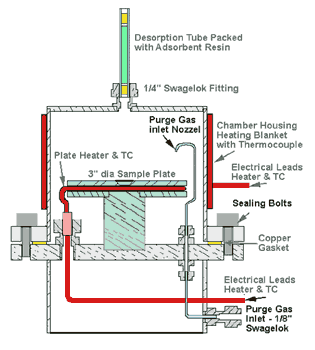
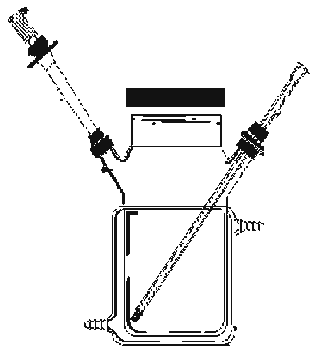
Figure 1. Heated Sampling Chamber (A) and Purge & Trap vessel (B)
The liquid crystal display was also considered a likely source of the silicone contamination, and a single display was provided for Purge and Trap testing. Two of the handheld instruments were also sampled in their entirety by P&T. The objective was to evaluate the use of a potting resin to halt fugitive siloxane emissions from the LCD. P&T-TD-GC-MS was performed by isolating the pieces to be studied in a heated sampling chamber or a glass Purge & Trap vessel (both from SIS, Inc.) and purging with nitrogen onto a GLT packed with 100 mg Tenax® TA (SIS, Inc.). Tenax GLT traps were conditioned for 2 hours at 300 >°C with nitrogen flow. Whole units were each sampled for 60 minutes at 100 >°C with a flow of 100 ml/min through the P&T vessel (Figure 1B). The vessel was kept at temperature by placing it in a laboratory oven and plumbing purge gas and sampling ports outside of the oven. A sample was collected from the LCD by placing it in a heated sampling chamber (Figure 1A) set at 80 >°C and purging at 100 ml/minute for 30 minutes. The exposed LCD was considered likely to emit more siloxane materials at lower temperature than the enclosed and assembled instruments.
|
Table 1 - System Parameters |
||
|
DTE Analysis |
P&T Analysis |
|
| Thermal Desorption Parameters | ||
| Purge time | 1 minute | 1 minute |
| Inject time | 1 minute | 1 minute |
| Desorb time | 5 minutes | 5 minutes |
| Desorption temperature: | ||
| Initial: | 50 >°C no hold | 250 >° C Isothermal |
| Rate: | 20 >°C/minute | |
| Final: | 150 >°C no hold | |
| Cryotrap Temperature: | ||
| Cooling: | -70 >°C | -70 >°C |
| Heating: | 260 >°C | 260 >°C |
| GC Parameters | ||
| Inlet Temperature: | 250 >°C | |
| Oven Program: | ||
| Initial: | 40 >°C no hold | |
| Rate: | 10 >°C/minute | |
| Final: | 280 >°C hold 5 minutes | |
| Split: | 20:1 | |
| MSD Parameters | ||
| Mode: | 70eV EI/Scanning | |
| Scan range: | 35-350 amu | |
| Source Temp: | 250 >°C | |
| Quad Temp: | 150 >°C | |
|
Transfer Line Temp: |
280 >°C | |
Thermal Desorption and Direct Thermal Extraction were performed using the AutoDesorb™ model 2000 automated thermal desorption system (SIS Inc. Ringoes, NJ) for analysis. Separation and detection were performed with and Agilent (Palo Alto, CA) 6890 GC and 5973 MSD in EI mode. Thermal desorption, GC and MS parameters are given in Table 1.
Results and Discussion:
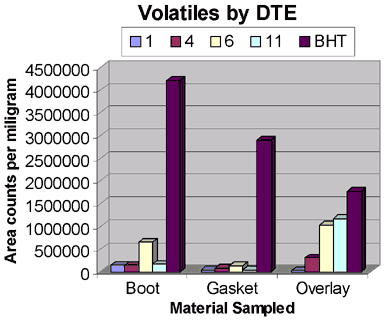
Figure 2
The polymer materials were analyzed by DTE, with sample sizes of 4.8 mg, 5.0 mg, and 7.4 mg for the boot, gasket, and overlay respectively. The analysis was intended to be qualitative, so no standard was added to the desorption tubes. Results are presented in terms of area response per milligram of sample to relate approximate relative emission rates. Four cyclic siloxane oligomers were consistently seen in the DTE samples. They are listed as compound #s 1,4,6,and 11 in Table 2. Spectra are presented in Figure 6. BHT was also found in all of the samples, and area counts for this compound are also reported. BHT levels did not appear to correlate with siloxane emissions in this small sample, however this may be expected as the samples were of different materials. Results are presented in Figure 2.
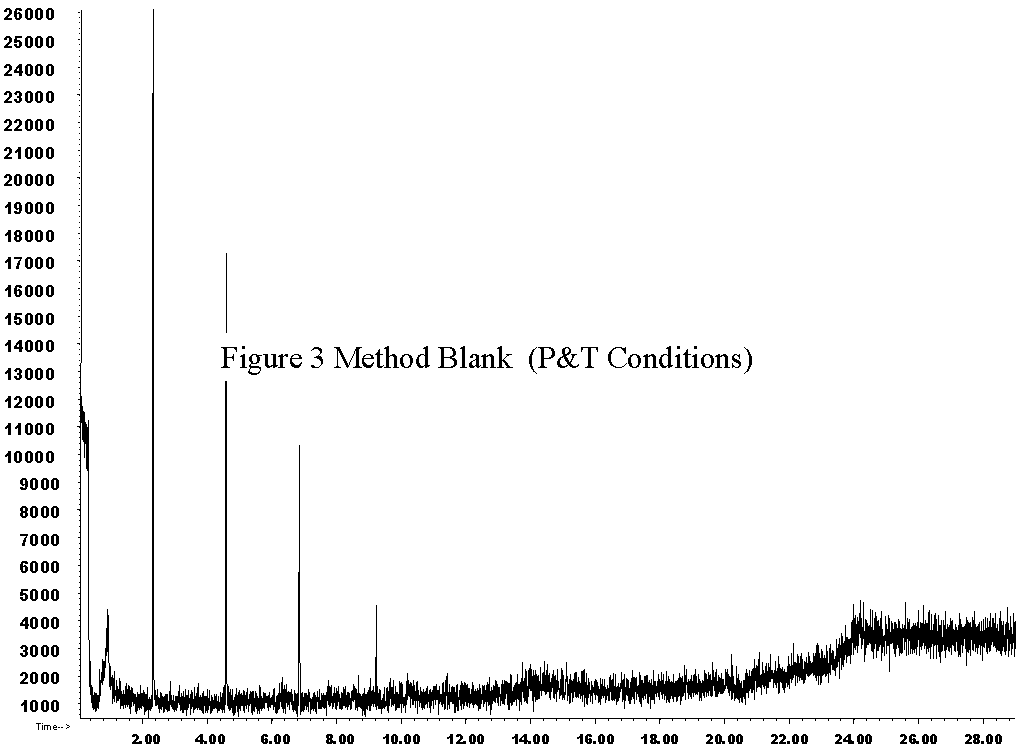
Figure 3
Figure 3 shows a blank run by the P&T method and Figure 4 is the Total Ion Chromatogram from the LCD sample. Results of the whole-instrument and LCD analyses are presented in Figure 5. Interestingly, the potted sensor unit displayed a higher amount of siloxane material in the sample than the unpotted unit. This discrepancy may be due to random variation in silicone materials used in the instruments, or it may have been the result of an unnoticed leak in the sampling device. The relative amounts of silicone compounds and BHT, however, remain similar between the samples. The LCD yielded the most volatile material of any of the samples. In addition to greater quantity, there was also a greater variety, as the LCD emitted several siloxane compounds that were not detected in the other samples. This is probably due to the efficiency of the heated sampling chamber relative to the glass P&T vessel, as well as the fact that the LCD possessed the largest pool of silicone of any component in the sensor. Relative amounts of BHT did not correlate with the whole-instrument samples. Because standards were not used, the results are merely qualitative, however the gross differences between samples and the large amount of siloxane materials found in the LCD provide evidence that it is this part that contributes most of the contaminating material. The manufacturer of the detector can use this information verify that silicone-free specifications are being met by suppliers.
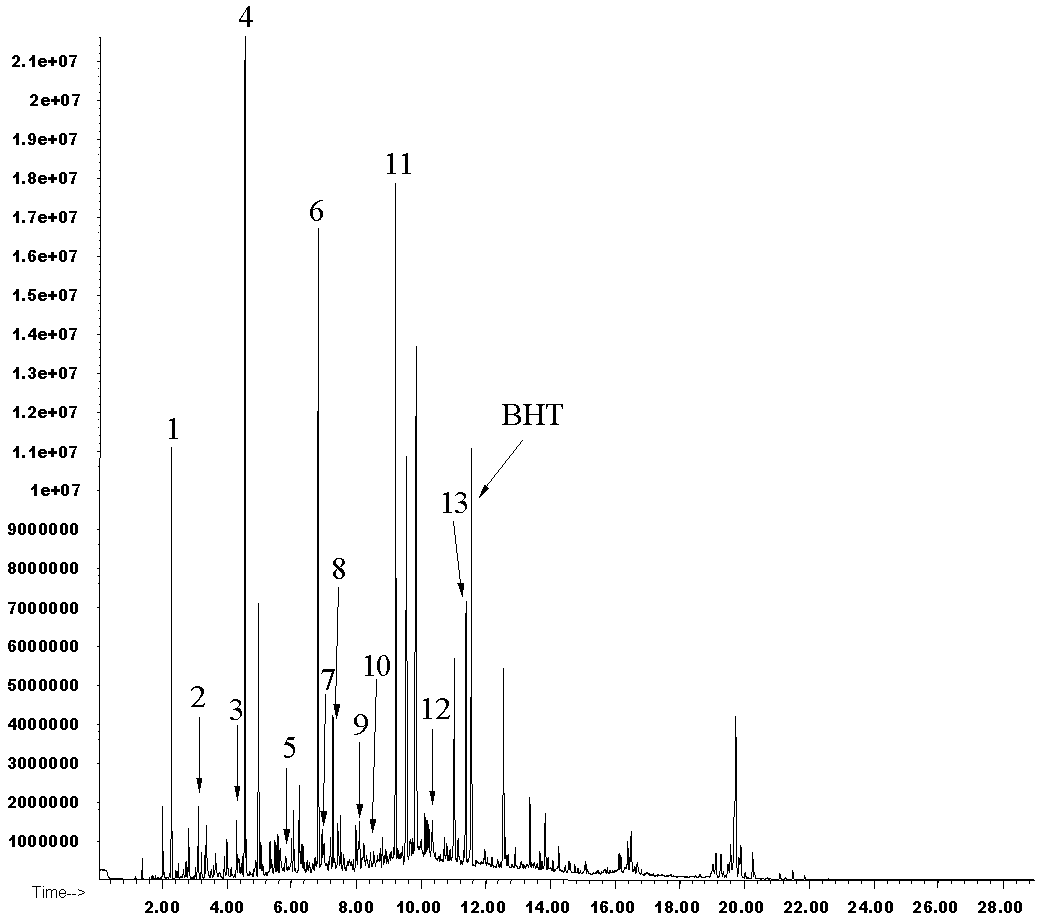
Figure 4
Quantitative and semi-quantitative analysis is possible with these methods with only minimal extra work. Once a response factor can be established for the siloxanes with respect to an internal standard, the DTE samples can be spiked with the internal standard for quantitative analysis. Likewise, the P&T samples may be spiked either during sampling by placing a standard in with the sample as it is being collected. Alternatively, the adsorbent tube may be spiked after sampling is complete to provide a known level of standard on column. The major difficulty in establishing quantitative methodology for silicone materials by GC is that most of the capillary columns that yield good peak shapes for these substances are themselves manufactured with silicon bonded phases. Several steps can be taken to minimize the background contribution from the GC system. First , an alternative to silicone-based inlet septa should be in place. The AutoDesorb™ system works well with the Merlin Microseal inlet device, provided care is taken in installation, and injection speed is not too fast. Additionally, any bonded phase should be kept away from the hot inlet. A suitable length of deactivated fused silica guard column should be used, and whole-oven cooling should be avoided. Blanks should be run frequently to assure consistently low levels of siloxane materials from the GC inlet and column.
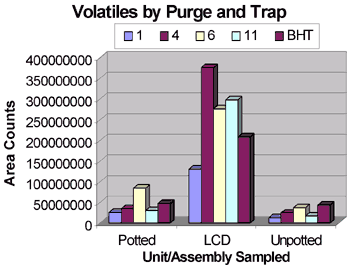
Figure 5
Table 2. - Siloxane Compounds from Components of Handheld Hydrocarbon Sensor.
| Compound No. | |
| 1 | Hexamethyl cyclotrisiloxane |
| 2 | Octamethyl trisiloxane |
| 3 | 1,3-Bis(trimethylsilyl) benzene |
| 4 | Octamethyl cyclotetrasiloxane |
| 5 | Decamethyl tetrasiloxane |
| 6 | Decamethyl cyclopentasiloxane |
| 7 | |
| 8 | Dodecamethyl pentasiloxane |
| 9 | |
| 10 | Unknown MW silicone cpd BP at 415 fragments at 399,327 |
| 11 | Dodecamethyl cyclohexasiloxane |
| 12 | Tetradecamethyl hexasiloxane |
| 13 | Tetradecamethyl cycloheptasiloxane |
| 14 | Butylated Hydroxytoluene |
* Compounds 7 and 9 are discrete peaks, but present spectra that are identical to compounds 6 and 8 respectively. These may be structural isomers, or possibly evidence of sample overload. They are detected only in the LCD sample.
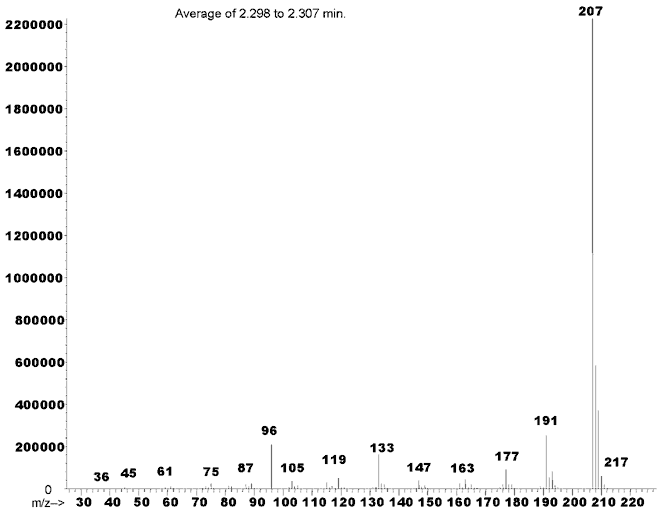
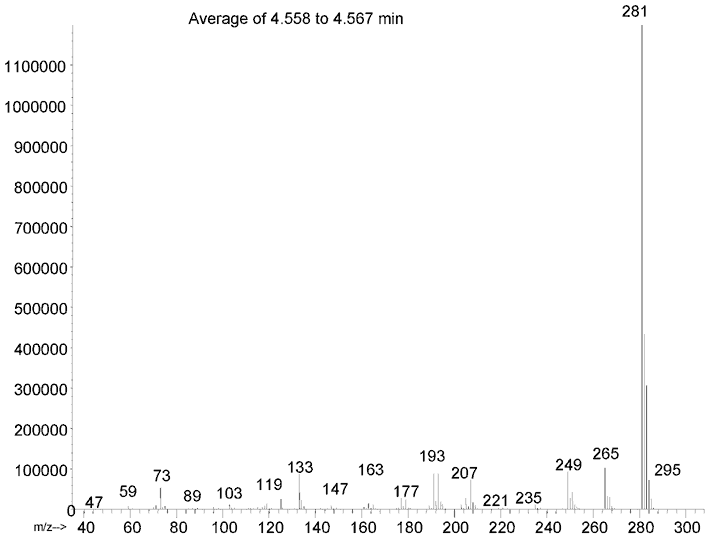
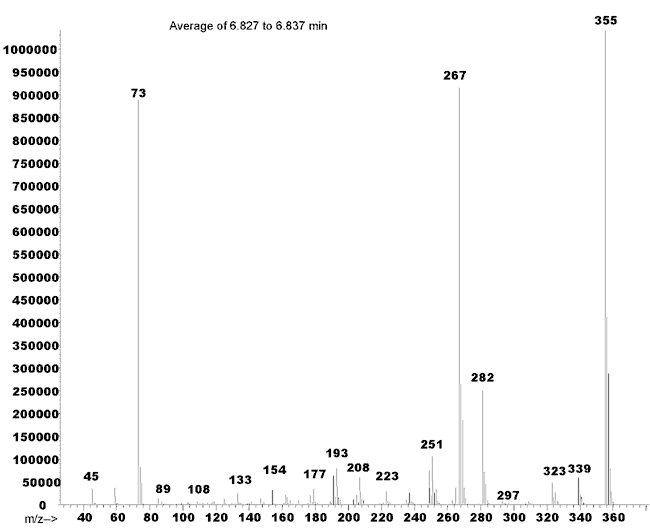
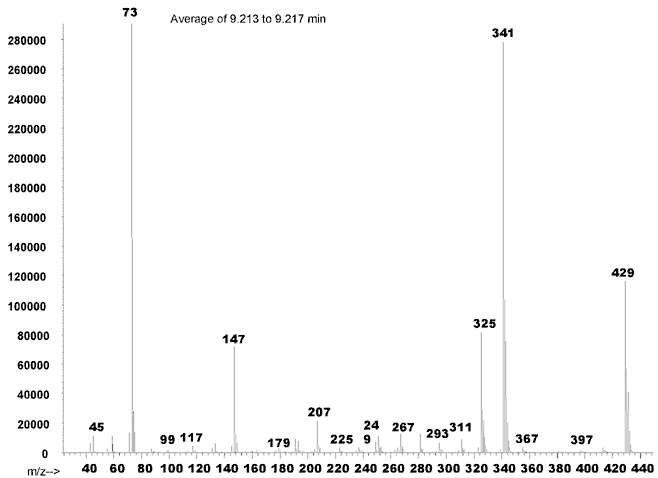
Figure 6. Representative Spectra of Common Siloxanes
Conclusion:
A simple, sensitive method is described to determine the source and extent of volatile off-gassing of silicone and other volatile substances from small electronic devices or components. The method can be expanded with minor changes to provide quantitative results suitable for process monitoring, quality control, and setting engineering specifications. Successful execution depends on control of background silicone artifacts from the GC.

